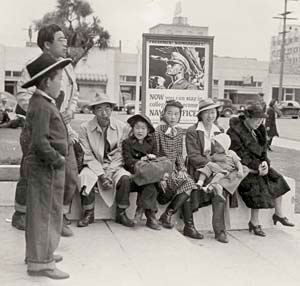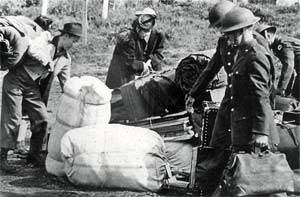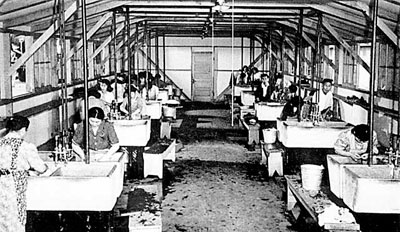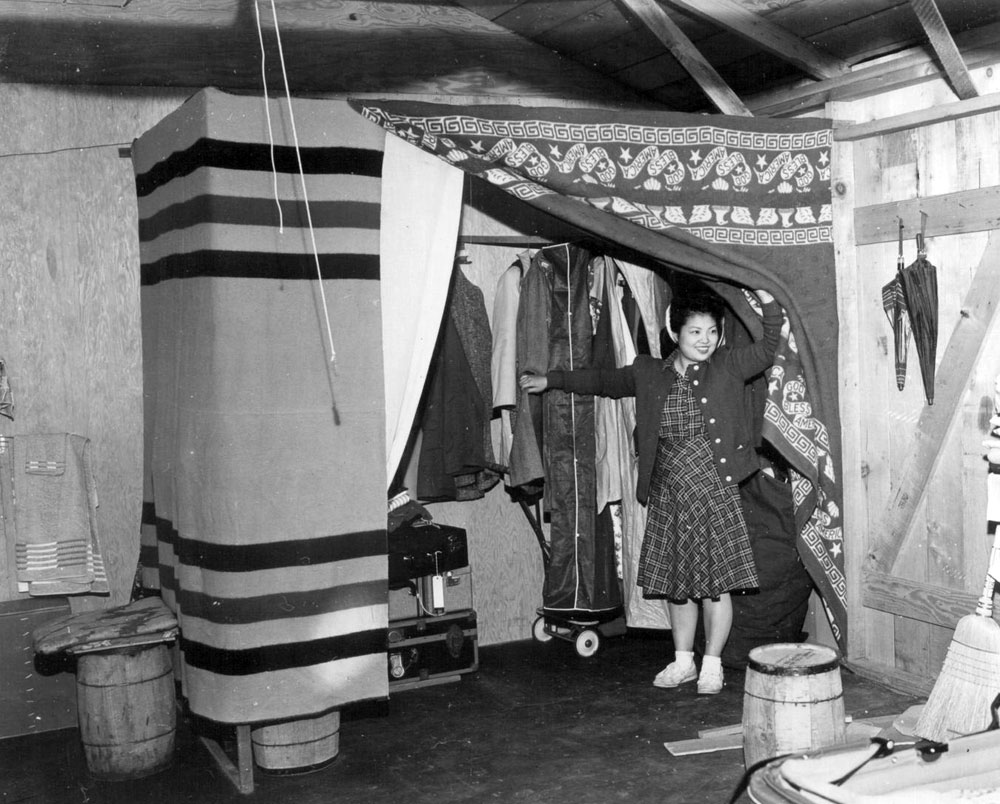A Way Station on a Longer Journey
Most Japanese Americans went to assembly centers without protest, hoping their compliance would prove their loyalty. Still, they harbored worries about what would become of them. Salem area minister Andrew Kuroda gave voice to the apprehension in a letter to friends in early May, before leaving for the Portland Assembly Center:
Transition to the Assembly Center
Once the evacuees navigated the local Civil Control Station and received instructions on when to report to the assembly center, the frenetic transition began. - for some more than others. Newton Uyesugi, President of the Japanese American Citizens League, arrived at the center late, but with good cause. The "stress and strain of packing" caused his wife to go into labor three weeks early. As Uyesugi recounted: "the baby came before we had a chance to go to the hospital. On top of that, Dr. Shiomi was already at the assembly center; therefore, we had no doctor, and when we got her to the hospital, an interne [sic] finished the job." Because of the "harrowing experience," officials granted him a temporary extension allowing for his late arrival at the assembly center.
Footnote
2
While the individual circumstances of evacuation varied, the Hood River County District Attorney, Tuenis Wyers, captured one scene: "The evacuation of these people was quite pathetic at least in a number of cases. Many of the older folks wept and I think most of the younger ones were quite satisfied that they would never be permitted to return. I know that I myself was very sorry for at least one or two of the evacuees because I feel that they probably were spiritually American."
Wyers went on to indict the Caucasian population of the area: "The practically unanimous reaction of the townsfolk and the farmers of this valley, however, has surprised me. There is an almost vicious and almost universal attitude that they must never return -- that their coming here was wrong and that the valley is far better off without them. One hears this even from those who had close personal friends among the evacuees."
 Letter from Teunis J. Wyers to Gov. SpragueFootnote
3
Letter from Teunis J. Wyers to Gov. SpragueFootnote
3Assembly Center Overview
 Evacuees wait for a bus to an assembly center. (National Archives, image no. ARC 536195)
Evacuees wait for a bus to an assembly center. (National Archives, image no. ARC 536195) Officials described an assembly center as "merely a way-station" to the war-duration relocation area. It was a temporary collecting place where evacuees were provided with food, shelter, medical care and protection while more permanent relocation camps were selected and constructed.
Footnote
4 The Army operated 15 centers on the West Coast from late March to late October 1942. The Portland Assembly Center operated from May 6 to September 10 and reached a peak population of 3,676 on June 6.
Footnote
5
The center was converted for use from its previous role as a livestock center on the county fairgrounds. Thin sheets of plywood were set up to divide the existing building into housing "apartments" for four, six, eight, or ten individuals. Since the alterations were designed to be temporary, many of the plywood walls only extended part way to the ceiling, further limiting privacy. A typical unit may have 200 square-feet of space with a single, bare light bulb. While mattresses were provided at the Portland center, other locations only provided a mattress ticking that had to be filled with hay or straw.
Footnote
6 Owing to the previous use of the building, evacuees tolerated the strong smell of livestock dung.
Life in the Center
Generally, Japanese Americans entered the assembly centers resigned to their fate but determined to make the best of it. For example, Newton Uyesugi looked on the bright side upon arriving at the "very large" Portland Assembly Center: "The mere physical exertion of walking around this center makes one very tired; but I presume it is very good for an individual to exercise once in a while."
Footnote
7Internal Organization
Uyesugi jumped right to work inside the center. He helped out on the administrative board, which was only temporary. A general election would wait until more people arrived and became more organized. This advisory group included Uyesugi, a Methodist preacher, a Buddhist reverend, and a past president of the Japanese American Citizens League. They met daily with the center administrator, E. Sandquist, whom Uyesugi described as "a very fair, tolerant, and just person," to coordinate the functions of the center.
Footnote
8
 Evacuees move to the Portland Assembly Center. (Image courtesy Oregon Nikkei Legacy Center)
Evacuees move to the Portland Assembly Center. (Image courtesy Oregon Nikkei Legacy Center) Within the confines of living in a converted livestock center, people tried to make life comfortable. Scraps of lumber and other materials were converted into tables, chairs, shelves, stools and other furniture. Radios, hotplates, and other electrical items added to the comfort but also sometimes caused the inadequate electrical system to blow a circuit, leaving people in the dark.
Footnote
9 Temperatures varied widely as Uyesugi lamented in concern for the small children and older people: "It is rather cold in the mornings since there is no heat in the rooms, but on days when the sun shines, the afternoons become very hot."
Footnote
10 Police and Fire Services
The evacuees formed their own police and fire departments with the Portland Assembly Center. Military police patrolled outside the center to prevent unauthorized entry or departure. Inside, eight unarmed civilian officers provided security with the evacuee police department assisting. As Uyesugi noted: "...the military passes up and down outside the barbed-wire fence, but inside we govern ourselves. The military will not step in unless there is a riot." A curfew ran from "lights out" at 10:30 p.m. to 6 a.m. but its observation was variable.
Fire was seen as a big hazard and the evacuees who were part of the fire department took shifts to provide protection around the clock. Uyesugi pointed out the danger: "Yesterday, we had our first fire drill and everyone was out of the building within three minutes. Still, when one considers the fact that this place has burned down three times, and the last time it burned, the building was in ashes in twenty-eight minutes, you can imagine that three minutes is [a] very good time, but it does not give us a great deal of leeway."
Footnote
11Meals and Diets
 Women work in the laundry room at the Portland Assembly Center. (National Archives image)
Women work in the laundry room at the Portland Assembly Center. (National Archives image) Meals at the Portland Assembly Center were prepared by evacuees under administration direction. Waitresses served food family style in two large dining halls. Despite their size, the dining halls could not accommodate all the people at once, thereby necessitating two dining shifts. About 150 people worked in the mess halls and kitchens where dishwashing was done by hand. Families with small children ate in a special section. In the early days, the Army supplied "B-rations" consisting of canned goods, smoked meats, beans, rice, flour and sugar. Later arrangements provided for the purchase of food from stores near the center. The Portland center benefited from the services of the two best Japanese cooks in the area.
Footnote
12 But, cooks had to cope with varied dietary needs of thousands of people: "...we have diabetics, people with stomach ulcers, and others who cannot eat regular food," noted Newton Uyesugi. The center experienced problems early on because one- to six-year-old babies were being fed the same diet as the adults. The resulting illnesses caused the military doctor to consider changes to the diet.
Footnote
13 Medical Services
Medical services were provided at the hospital-medical complex located to the east of the main recreation building. The complex had a 25-bed ward for men and one for women in addition to a 10-bed isolation ward. An officer with the U.S. Public Health Service oversaw medical services with the assistance of two evacuee doctors and four nurses. The facility functioned as an infirmary with serious operations referred to local medical centers. The first communicable disease reported was whooping cough. That caused worry and sleepless nights for evacuees such as Saku Tomita of Portland. She wrote in her diary: "Last night, I did not get a bit of sleep because the Kurihara children next door were coughing alternately all night with whooping cough. I can imagine the trouble and anxiety this must cause their parents Mr. and Mrs. Kurihara, and I truly sympathize with them." Overall, the center saw four deaths and 23 births during its operation.
Footnote
14Art and Recreation
 A woman shows off her makeshift assembly center closet. Evacuees proved remarkably resourceful in creating a more livable environment. (Image j15HA-221A courtesy the Bancroft Library. University of California, Berkeley)
Enlarge image
A woman shows off her makeshift assembly center closet. Evacuees proved remarkably resourceful in creating a more livable environment. (Image j15HA-221A courtesy the Bancroft Library. University of California, Berkeley)
Enlarge image Recreation helped the evacuees relieve the boredom and oppression of involuntary confinement. In fact the first night that the center was occupied "people rigged up a phonograph and loud speaker system to provide music for a dance." Talent shows, art exhibits, pageants, concerts, films and other activities filled the time as well.
Footnote
15 Evacuees set up recreational facilities including basketball courts, volleyball courts, and baseball diamonds. Other pursuits included chess, darts, badminton and checkers. The evacuees also set up a canteen where items were sold at cost and they could order items through the Sears catalog.
Footnote
16 A True Way Station
Over the course of its operation, the Portland Assembly Center saw a constant stream of people arriving and departing. As new areas of the exclusion zone were cleared and Japanese Americans were ordered to appear at the center, sometimes large numbers were added to the population. For instance, June 4 saw the arrival by train of 524 new evacuees from the Wapato, Washington area. The next day a group of 530 arrived by train with 99 more people coming in by bus. Likewise, large groups departed for relocation camps or for work in agricultural labor. On May 26 Transfer Order No. 1 moved 250 people to the Tule Lake Relocation Center in California just south of Klamath Falls. While the length of the stay varied from one person to the next, the center lived up to its description as "merely a way station" for most evacuees before they embarked on the next chapter of their forced journey.
Footnote
17Making the Best of It
While at the camp, Newton Uyesugi summed up what might have been the attitude of many of the Japanese Americans in the Portland Assembly Center:
On the Whole, everyone is taking the situation very nicely. We are doing our utmost to keep up the morale of the people. I must say there is not one of us who would rather not be outside of these walls since this is so abnormal. Having a great number of people cooped up together in one place is not exactly to anyone's liking; but the general attitude is that since we must stay here, we will make the best of it. Everyone agrees that since he has been put into the center, he has received every consideration and fair treatment.
Footnote
18Notes